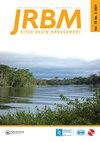Analysis of spatio-temporal variation of hydroclimatic variables of the Krishna river basin under future scenarios
IF 2.2
Q3 WATER RESOURCES
International Journal of River Basin Management
Pub Date : 2022-05-21
DOI:10.1080/15715124.2022.2079656
引用次数: 0
Abstract
ABSTRACT Climate change and intensified human activities are expected to alter the natural hydrological cycle would cause changes in the distribution of water resources and their availability across space and time. Therefore, the present study focused on understanding the spatiotemporal variations of hydroclimatic variables namely rainfall, surface runoff, water yield, and the Aridity Index (AI) of the Krishna River Basin (KRB) under combined impact of climate and Land Use/Land Cover (LULC) change scenarios. From trend analysis, the best model (CNRM-CM5 driven RCM) projected an increasing trend in rainfall under both RCP 4.5 and 8.5 scenarios for the entire century. Results indicated that, except for the central part, most of KRB experiences high runoff and water yield conditions under both RCP 4.5 and 8.5 scenarios in the mid and end centuries, conversely it may face low runoff and water yield conditions in the early century. Most of the central part is in arid and semi-arid conditions and, the eastern part of the basin is in dry sub-humid conditions, while the Western Ghats, Palleru, and Munneru regions of the basin fall under humid and hyper humid regions under RCP 4.5 scenario. Whereas the majority of the basin falls under humid and hyper humid regions under RCP 8.5 scenario except for the central and few other parts of the basin. In light of this, it was essential to review the current water management strategies and plan future projects to provide efficient and effective ways to mitigate the adverse impacts resulting from climate variability.未来情景下克里希纳河流域水文气候变量时空变化分析
本文章由计算机程序翻译,如有差异,请以英文原文为准。
求助全文
约1分钟内获得全文
求助全文
来源期刊

International Journal of River Basin Management
WATER RESOURCES-
CiteScore
6.00
自引率
4.00%
发文量
48
期刊介绍:
include, but are not limited to new developments or applications in the following areas: AREAS OF INTEREST - integrated water resources management - watershed land use planning and management - spatial planning and management of floodplains - flood forecasting and flood risk management - drought forecasting and drought management - floodplain, river and estuarine restoration - climate change impact prediction and planning of remedial measures - management of mountain rivers - water quality management including non point source pollution - operation strategies for engineered river systems - maintenance strategies for river systems and for structures - project-affected-people and stakeholder participation - conservation of natural and cultural heritage
 求助内容:
求助内容: 应助结果提醒方式:
应助结果提醒方式:


